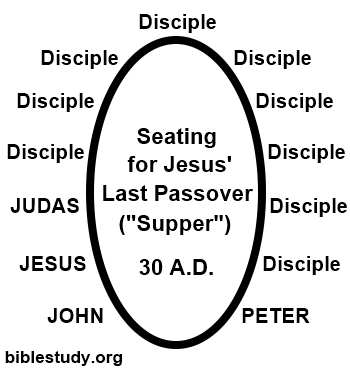The seating of guests in chairs, implied in Leonardo da Vinci's Last Supper painting, were not used for this most solemn occasion. Based on Jewish law and tradition, Passover (and most meals) was partaken of while people reclined around a low, long oval table. Each person would be lying on their left side and leaning on their left arm, with their feet behind them and their heads facing the table.
This traditional way of sitting on their left sides meant the disciple's bodies were somewhat facing the end of the table. This position, during a meal like the last supper, frees up the right arm for eating.
Jesus was the host of this unique "supper" (it was actually an observance of the Passover). Although the Bible does not directly state the seating for this last meeting, we can deduce, however, where Judas, Jesus, Peter, and John had to have sat.

In the above diagram of the last supper seating, Judas is sitting to the left of Jesus, in the place designated for the most honored guest. Although the host would normally select who sat next to him (see Luke 14:7 - 11), no record exists of Christ asking Judas to sit next to him. Judas likely felt he deserved to be the honored guest at the supper and quickly claimed the choice position as his right (Life and Times of Jesus the Messiah, Book 5, Chapter 10).
It should also be noted that Peter, in the seating diagram above, is located across from John at the end of the table. This was, especially during this most solemn "last supper," the lowest and most humble place at the table.
Evidence
What evidence from the Bible exists to show that the above seating arrangement for Christ's last gathering with his disciples is correct? Scripture states that Peter had to get John's attention in order to request that he ask Christ who will betray him.
As He was saying these things, Jesus was troubled in spirit, and testified, saying, "Truly, truly I tell you, one of you shall betray Me."
Now one of His disciples, the one whom Jesus loved, was leaning on Jesus' chest. And so, Simon Peter motioned to him to ask who was the one of whom He was speaking (John 13:21, 23 - 24, HBFV).
Peter would not need to motion to John if he sat right next to him. Peter, however, had to be close enough to John such that his request could NOT be heard by others. John then leans on Jesus' chest to ask him Peter's question.
Then he (John) leaned back on Jesus' chest and asked Him, "Lord, who is it?" Jesus answered, "It is the one to whom I shall give a sop after I have dipped it." And when He had dipped the sop, He gave it to Judas Iscariot, Simon’s son (John 13:25 - 26, HBFV).
Given how people sat to partake of a meal, John had to be immediately to Jesus' right while at the table. This position enabled him to slightly lean back and be against the Lord's chest.
Additionally, the exchange that involved Peter, John, Christ and Judas was quiet and close enough such that the other disciples at the "supper" had no idea what was said. This meant they did not know the betrayer would be the one given a piece of bread (the "sop") during supper.
And after the sop, Satan entered into him (Judas). Then Jesus said to him, "What you do, do quickly." But not one of those sitting at the table knew why He said this to him (John 13:27 - 28, HBFV).
The host of a formal meal or supper would give the "honored guest" at the table the first "sop." The sop was a piece of bread or other small amount of choice food that is dipped in a sauce. The host, once he had the sop, would place it into the mouth of the honored guest. This guest always sat to the left of the host, whom the Bible clearly states was Judas Iscariot (John 13:21, 25 - 26).
After he received the sop, Judas asked if he was the betrayer, which Christ affirmed that he was. Satan then immediately possesses Judas and he leaves the room.
Then Judas, who was betraying Him, answered and said, "Am I the one, Master?" He said to him, "You have said it." (Matthew 26:26, HBFV).
The nine disciples who did not hear what was discussed are clueless regarding what was happening. They thought the Lord was instructing Judas to give money to the poor or to buy those things needed to keep the Feast of Unleavened Bread.
But not one of those sitting at the table knew why He said this to him; For some thought, since Judas had the bag (the group's money bag), that Jesus was telling him, "Buy the things that we need for the feast"; or that he should give something to the poor (John 13:28 - 29, HBFV).
Jesus, after partaking of his last Passover ("supper"), then gives several teachings to his disciples before they leave for the Garden of Gethsemane (John 13:31 - 14:31).